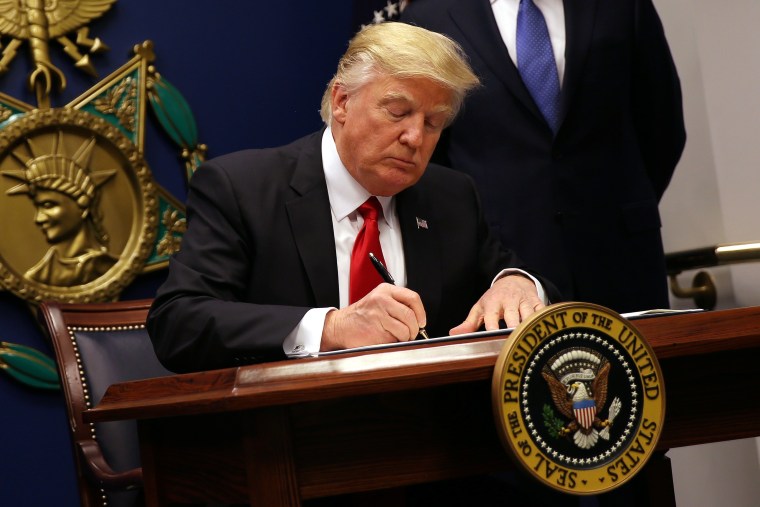Two senior White House officials told NBC News that President Donald Trump plans to sign a revised version of his executive order that restricted travel from seven Muslim-majority nations on Monday.
Since a federal judge in Seattle issued a temporary restraining order on it in early February, different White House officials and the president have stated numerous times that the new executive order would be signed soon. But more than a month after it was barred, the revised version has not been realized.
The delay would seem to undercut the White House’s original argument for its swift execution, which created confusing travel situations and immigration statuses for hundreds of people the weekend it was implemented. When its necessity and legality was challenged, the president and senior administration officials emphasized the need for travel restrictions because they believed the nation would be at risk without them.
These are the developments since the executive order was first signed.
Jan. 27: The executive order restricting travel from seven Muslim-majority nations is signed by President Trump.
Jan. 30: On “Fox and Friends,” senior policy adviser Stephen Miller said the executive order was an urgent priority because “if we waited five days, 10 days, six months to begin establishing the first series of controls,” then the administration would be leaving "the homeland unnecessarily vulnerable.”
Feb. 3: A federal judge in Seattle issued a nationwide temporary restraining order, effectively blocking the executive order.
Feb. 4: President Trump tweeted that the judge’s action means "many very bad and dangerous people may be pouring into our country.”
Related: Trump Travel Ban Makes America Less Safe: Ex-Top Security, State Officials
Feb 10: At a press conference with Japanese Prime Minister Shinzo Abe, President Trump hinted at new executive order “sometime next week,” stating that “we’ll be doing something very rapidly having to do with additional security for our country. You’ll be seeing that sometime next week."
Feb. 16: President Trump, at a news conference in the East Room, told reporters: “We're issuing a new executive action next week that will comprehensively protect our country."
Feb. 20: A senior White House official told NBC News that a new order is expected later in the week.
Feb. 23: Press Secretary Sean Spicer says: "It’s not a question of delaying, it’s a question of getting it right. We’ve taken the Court’s opinions and concerns into consideration, but the order is finalized. It’s now awaiting implementation."
Feb. 28: Prior to the joint address to Congress, a senior administration official told NBC News President Trump is expected to sign the executive order on March 1 at the Department of Justice.
Feb. 28: After the joint address to Congress, a senior official said the signing would be delayed in order let the president’s joint address breathe.
March 1: Press Secretary Sean Spicer told reporters that when the president is ready to make a decision on the timing of the revised immigration executive order, they’ll let reporters know "and we're not there yet."
March 4: Two senior administration officials said the president plans to sign the revised executive order on Monday.


